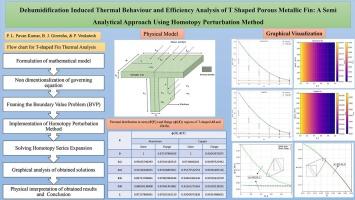Dehumidification induced thermal behaviour and efficiency analysis of T shaped porous metallic fin: A semi analytical approach using Homotopy Perturbation Method
IF 6.4
2区 工程技术
Q1 MECHANICS
International Communications in Heat and Mass Transfer
Pub Date : 2025-10-10
DOI:10.1016/j.icheatmasstransfer.2025.109814
引用次数: 0
Abstract
The novelty of this study lies in applying the Homotopy Perturbation Method (HPM) to analyse T-shaped porous metallic fin under dehumidification, a configuration that has not been explored in previous works. The research provides a comprehensive thermal and efficiency analysis of fin made of Copper (Cu) and Aluminium (Al), where condensation-driven heat and mass transfer within the porous medium is represented through Darcy's law. The governing nonlinear differential equations for the stem and flange regions are solved using HPM, with results validated against established literature. The thermal behaviour analysis shows that the stem maintains a higher temperature due to dominant axial conduction, rising by 14.62 % for Al and 8.64 % for Cu, while the flange remains relatively uniform with lower temperature gains of 0.23 % and 0.14 %. Cu fin outperform Al fin due to higher thermal conductivity, showing 8.64 % and 0.14 % increases in the stem and flange compared to 14.62 % and 0.23 % for Al. Higher relative humidity reduces temperature and efficiency through stronger condensation, while a larger length ratio lowers efficiency by extending the conduction path, with other parameters also analysed for their impact on fin performance. This study improves fin design for humid environments, benefiting heat exchangers and dehumidifiers.

T形多孔金属翅的除湿热行为及效率分析:同伦摄动半解析方法
本研究的新颖之处在于应用同伦摄动法(HPM)分析了t形多孔金属翅在除湿条件下的结构,这是以前的工作中没有探索过的。该研究对铜(Cu)和铝(Al)翅片进行了全面的热学和效率分析,其中多孔介质内冷凝驱动的传热传质通过达西定律表示。采用HPM方法求解了阀杆和法兰区域的非线性微分方程,并对已有文献进行了验证。热行为分析表明,由于轴向传导的主导作用,阀杆保持较高的温度,Al升高14.62%,Cu升高8.64%,而法兰保持相对均匀,温度增益较低,分别为0.23%和0.14%。Cu翅片的导热性能优于Al翅片,其阀杆和法兰的导热性能分别提高了8.64%和0.14%,而Al翅片的导热性能分别为14.62%和0.23%。较高的相对湿度会通过更强的冷凝降低温度和效率,而较大的长度比会通过延长传导路径降低效率,其他参数也会对翅片性能产生影响。这项研究改进了潮湿环境下的翅片设计,有利于热交换器和除湿器。
本文章由计算机程序翻译,如有差异,请以英文原文为准。
求助全文
约1分钟内获得全文
求助全文
来源期刊
CiteScore
11.00
自引率
10.00%
发文量
648
审稿时长
32 days
期刊介绍:
International Communications in Heat and Mass Transfer serves as a world forum for the rapid dissemination of new ideas, new measurement techniques, preliminary findings of ongoing investigations, discussions, and criticisms in the field of heat and mass transfer. Two types of manuscript will be considered for publication: communications (short reports of new work or discussions of work which has already been published) and summaries (abstracts of reports, theses or manuscripts which are too long for publication in full). Together with its companion publication, International Journal of Heat and Mass Transfer, with which it shares the same Board of Editors, this journal is read by research workers and engineers throughout the world.

 求助内容:
求助内容: 应助结果提醒方式:
应助结果提醒方式:


